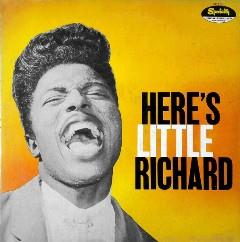Little Richard – Here's Little Richard (1957)
Little Richard – Here's Little Richard (1957)

A1 Tutti Frutti 2:25 A2 True Fine Mama 2:43 A3 Can't Believe You Wanna Leave 2:26 A4 Ready Teddy 1:51 A5 Baby 2:02 A6 Slippin' And Slidin' 2:44 B1 Long Tall Sally 2:07 B2 Miss Ann 2:16 B3 Oh Why? 2:05 B4 Rip It Up 2:20 B5 Jenny Jenny 2:02 B6 She's Got It 2:08 Little Richard And His Band
Little Richard had been making records for four years before he rolled into Cosimo Matassa's J&M Studio in New Orleans and cut the epochal "Tutti Frutti" in the fall of 1955, but everything else he'd done -- and much of what others had recorded -- faded into insignificance when Richard wailed "A wop bop a loo mop a lomp bomp bomp" and kicked off one of the first great wailers in rock history. In retrospect, Little Richard's style doesn't seem so strikingly innovative as captured in 1956's Here's Little Richard -- his boogie-woogie piano stylings weren't all that different from what Fats Domino had been laying down since 1949, and his band pumped out the New Orleans backbeat that would define the Crescent City's R&B for the next two decades, albeit with precision and plenty of groove. But what set Richard apart was his willingness to ramp up the tempos and turn the outrage meter up to ten; "Tutti Frutti," "Rip It Up," and "Jenny Jenny" still sound outrageous a half-century after they were waxed, and it's difficult but intriguing to imagine how people must have reacted to Little Richard at a time when African-American performers were expected to be polite, and the notion of a gay man venturing out of the closet simply didn't exist (Richard's songs were thoroughly heterosexual on the surface, but the nudge and wink of "Tutti Frutti" and "Baby" is faint but visible, and his bop threads, mile-high process, and eye makeup clearly categorized him as someone "different"). These 12 tunes may not represent the alpha and omega of Little Richard's best music, but every song is a classic and unlike many of his peers, time has refused to render this first album quaint -- Richard's grainy scream remains one of the great sounds in rock & roll history, and the thunder of his piano and the frantic wail of the band is still the glorious call of a Friday night with pay in the pocket and trouble in mind. Brilliant stuff. ---Mark Deming, AllMusic Review
Ja wiem, że Little Richard miał niepośledni wpływ na muzykę. Rozumiem, że Tutti Frutti to jeden z najważniejszych utworów w historii muzyki. Ale przyznać się – kto z Was słucha płyt w kolejności chronologicznej? No jasne, że nikt. Mamy prawo oczekiwać, by płyta broniła się poza kontekstem historycznym. I oczywiście Here’s Little Richard się broni – ale nie tak bardzo, jak oczekiwaliby tego puryści. Jedyne bowiem, co tu znajdziemy, to bardzo sympatyczne pomieszanie rock and rolla i brzmień z pogranicza bluesa i country. Ten ostatni gatunek odzywa się zwłaszcza w miejscach, gdzie do głosu dochodzi pianinko rodem z saloonu (Slippin’ and Slidin’). Jednak to nie ono robi największe wrażenie – całą oryginalność kreują bowiem saksofony, których pochody nadają tej płycie tzw. wysokiego połysku. Wierzcie mi lub nie, ale to naprawdę oryginalny element tego krążka, stąd warto zwrócić nań uwagę.
Nie ukrywam, że Here’s Little Richard to debiut niezwykle dojrzały. Richard Penniman ma głos tak charyzmatyczny, że po prawie sześćdziesięciu latach wciąż robi on wrażenie. Nawet dziś mało który rockman może pochwalić się pomieszaniem takiej chrypy i umiejętności czystego wyciągania góry. W połączeniu z krótkimi, dynamicznymi kompozycjami, krążek sprawia świetne wrażenie. Niestety, psują je dwie rzeczy, które trzeba uczciwie odnotować. Pierwszą z nich jest schematyczność. Słyszeć jeden hit Little Richarda to słyszeć je wszystkie. Zwrotki z akcentami i pauzami oraz rozhukany refren: oto przepis na Tutti Frutti, Ready Teddy oraz Long Tall Sally. I choć piosenki te się bronią, to brzmią podobnie. Drugi, większy minus, to brak klimatu. Oczywiście, przyjemnie jest sobie posłuchać tych brzmień czy trochę do nich pobujać, ale nie poczujemy nic ponad to. Ma być zabawa – i jest zabawa. Niestety, umyka gdzieś to, po co słucha się tych płyt – świadectwo epoki, w których zostały nagrane. Być może odpowiada za to – rzecz paradoksalna – świetna produkcja, która w ogóle się nie zestarzała. Ja mimo wszystko oddałbym wiele za trzeszczącego, z deka zdartego winyla.
Here’s Little Richard to płyta solidna – solidnie ją skomponowano i zagrano, nic więc dziwnego, że i po sześciu dekadach brzmi ona solidnie. Zarazem trudno o niej powiedzieć cokolwiek więcej. Choć zatem jest ona przełomowa, to brakuje powalającego argumentu, by dziś wracał do niej ktoś, kto nie jest miłośnikiem muzycznej archeologii – no chyba, że lubicie charyzmatycznych wokalistów z epoki saksofonów i kontrabasów. Cała reszta może zaś potraktować recenzowany dziś krążek jako niezobowiązującą ciekawostkę. A nuż zaskoczy? ---Jacek Jarocki, muzycznyhoryzont.pl
download (mp3 @320 kbs):








